My Journey from Bhutan to US - Officer Damber Subba
My Journey from Bhutan to US
- Written by Officer Damber Subba
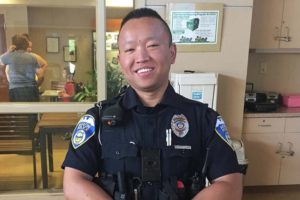
I was born in Bhutan. I’m from Lhothsampa (Southerner) ethnical group. My great-great grandparents migrated from Nepal to Bhutan and they became Citizens of Bhutan. We speak Nepali. Ngalop (Western and Northern Part) People were culturally dominant in the country. King, Royal Family, and Ministers are from Ngalop. Ngalop originally migrated from Tibet. They speak Dzongkha.
In 1980s, The Government of Bhutan, King, implemented “One Nation One People” policy. The policy was basically a propaganda against Nepali Speaking Bhutanese Citizens. It was an ethnic cleansing movement against us. We were forced to speak Dzongkha. We were forced to wear Ngalop’s outfit. Our Nepali books were burned by the royal army. We protested peacefully against the dictatorship Monarchial System and asked for a fair/impartial treatment. In return, we were tortured physically and mentally which resulted into hundreds of casualties on our side. We ended up leaving our village and our country Bhutan. Many people died in the jungle as we were escaping from the persecution. There were more than 100,000 people left the country.
I was only two and half year old when we left Bhutan. We settled on the bank of Mahi River, which is one of the borders between India and Nepal. We made a small hut from tree branches and leaves. Nothing was free and available, but water from Mahi River. I lost one of my older sisters from poor living situation. She was one of thousands who died in Mahi Camp from lack of food and nutrition and viruses. There was no health center. We stayed there over six month.
Eventually, UNHCR and Nepal Government CARITAS Nepal rescued us and put us in seven different camps in Eastern Part of Nepal. I spent 17 years in Beldangi – ll Refugee Camp. I remember vividly how it feels not to have food, clothes, and securities and to be discriminated from local people. I remember clearly how it feels for not able to dream who you want to be when you grow up. I remember like yesterday my parents struggle each and every single day to buy one pair of new school uniform for me or to buy a nice meal once in a year for Dashain and Tihar.
In 2008, USA, Denmark, Norway, Netherlands, Australia, Canada, and UK offered to resettle refugees. I chose USA since this is the “Land of Opportunities.” I even heard that heaven is only couple miles away from US. I came with my mom, dad, one younger brother, and two younger sisters in July 2008 in Akron, Ohio through the International Institute of Akron. I have been blessed to have agencies like IIA, Asian INC and other.
I worked in Akron Foundry Company at first and at the same time going to college and getting trainings to become a professional interpreter. I became Nationally Certified Medial Interpreter in Nepali Language and I started to work for Akron Children’s Hospital. It was very fulfilling experience to be conduit between immigrant community and mainstream population. I always enjoyed helping Healthcare Providers and Non-English Speaking patients.
In 2014, I became a US Citizen and that moment was one of the GREATEST moments of my life. As soon as I became a US Citizen I bought a big US Flag and hung in front of my house and a flag in my car. Then, I started to train to become a police officer so that I could be helpful for Akron Police Department and for the community. I was trying to find a way to give back to this community and ultimately to this country since this country have done so much to us.
I became an officer in Akron Police Department in 2018 and I was the first officer from refugee background. Since I became police, I was able to help so many people in so many different instances such as elderly person paralyzed lying in the house for couple days without any help, rescuing dogs, rescuing children, solving violent crimes and neighbors disputes due to cultural differences and so on. Every single day young boys and girls from different ethnical background such as from Bhutanese Nepali, Burmese, Karen, Congolese, and Afghans ask me how to become an officer. My one brother is Mechanical Engineer. The other brother is in military. Two sisters work in Hospital. I’m living the American Dream big time and I’m proud to be an American!
Gdańsk and Cleveland: Twin Cities and Twin Lighthouses - By Ezra Ellenbogen
Gdańsk and Cleveland: Twin Cities and Twin Lighthouses
- Written by Ezra Ellenbogen
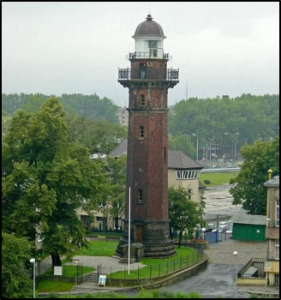
The Gdańsk Nowy Port Light, inspired by the Cleveland Harbor Lighthouse
Photo Credit to Nancy J. Rau via Lighthouse Digest
In 1893, a delegation from Gdańsk, Poland, visited Cleveland on their way to the World Exposition in Chicago.[1]There, the group saw the 1873 Cleveland Harbor Lighthouse, known as one of the most impressive American lighthouses in history. Later that year, the lighthouse had a Polish twin. Gdańsk’s Nowy Port lighthouse went into operation the following year, and even played a part in World War Two.[2] Gdańsk and Cleveland have had a long history of immigration, cultural exchange, and lighthouses, among other things.
Gdańsk (pronounced g-Dy-an-sk) and Cleveland originally pursued a sister city relationship under Mayor Ralph J. Perk, and the partnership was established in 1990 under Mayor Michael R. White.[3]
Polish immigration to Cleveland was critical to the city’s history, especially during its industrialization. Poles constitute one of the largest ethnicities in Cleveland and nearby areas.[4] The first major settlement of Poles in the Greater Cleveland region occurred in the late 1860s, in Berea, a suburb located south of the Cleveland Hopkins International Airport.[5] By 1870, 77 Poles lived in Greater Cleveland. Polish immigration to Cleveland soon picked up - cultural and political pressure and oppression in Prussian and Russian Poland drove a lot of Poles away. At the same time, Cleveland industries were rapidly growing, and transportation across the ocean was inexpensive. By 1920, Poles in the city numbered 35,024, with the highest amount of growth seen between 1900 and 1914. The entire state of Ohio reflected similar patterns, with the Polish population soaring to 67,579 by 1920.[6]
From the 1870s on, significant Polish neighborhoods began to form. Major early concentrations of Polish immigrants included Rolling Mills in Newburgh and the E-65th-Fleet Avenue area. The latter of the two saw significant growth from the 1920s to 1990s, and is now known as Slavic Village or Warszawa. The second major Polish settlement was Poznan, around 79th Street and Superior Avenue. The third early major Polish settlement rose about in Tremont, called Kantowo. In 1882, the Cleveland Rolling Mills Strike led to a considerable growth in Cleveland’s Polish population. Primarily Polish immigrants were recruited in New York to break the strike. Poles became the most prominent group in heavy labor and industry in the city.
Religion was a very important force in early Polish Cleveland politics. In fact, it was the center of the community’s largest conflict. Local church politics drove a division in the city after the removal of Father Anton F. Kolaszewski from the St. Stanislaus Parish in 1892. These church politics heavily divided the community, leading to the establishment of separate newspapers and fraternal organizations, and it even became a force that influenced local elections.
The Polish population of Cleveland peaked in 1930 with 36,668 people. By then, the Polish community of the city had multiple newspapers, banks, churches, and more. Even though religious conflicts within the community had worn down, political differences became chief divisions of Polish communities. Poles in Kantowo, which was originally settled by mostly Russian Poles, tended to be Socialist and tended to support Marshal Joseph Pilsudski. Poles in Warszawa, which was originally settled by mostly Prussian Poles, tended to be in favor of Ignace Paderewski. This was incredibly divisive for Poles in Cleveland. Even the two newspapers reflected the split, with The Wiadomosci being pro-Pilsudski, whereas The Monitor was anti-Pilsudski. Unifying Cleveland’s Polish community, even with the help of organizations, was difficult.
The German invasion of Poland temporarily put the issue aside. However, after World War Two, political divisions became prominent again, this time over opinions on the new Communist state of Poland.
Cleveland’s Polish community was much less divided on American politics, especially after the Great Depression. The city’s Polish community has been predominantly Democratic since then. One important thing to note is that Warszawa and its people have been represented much more within Cleveland politics than other Polish communities. Prominent Polish political figures from Cleveland include Joseph Sawicki, who was elected to the state house in 1906 and to the municipal court in the 1920s and 1930s.
After the 1930s, Cleveland’s Polish population began to decrease. It rose and fell numerous times for decades. However, nowadays, the urban area of Cleveland’s Polish population accounts for almost 33% of the entire state of Ohio’s Polish population.[7]
Cleveland and Gdańsk saw decades of positive interactions, trade, and events before tragedy struck (warning: mention of murder). On Sunday, January 13th, 2019, Paweł Adamowicz, a six-term mayor of Gdańsk, was stabbed brutally at a charity event in Cleveland; he died the next day at the age of 53. Adamowicz was a well-known liberal mayor who made historical strides in defending the rights of immigrants, refugees, and LGBTQ+ people in Gdańsk. The assailant had been released from jail within the past month, and blamed Adamowicz’s former political party, Civic Platform, for his jailing in 2014 following violent attacks.[8] A national mourning was held from the 18th to the 19th of January across Poland. Numerous cities, including Gdańsk and Warsaw, held events of mourning.
Cleveland and Gdańsk’s partnership have had a positive legacy of immigration, cultural exchange, and more, even if there is a tragic event that taints it. Adamowicz will live on in Cleveland and Gdańsk’s heart. As sister cities, the two have built each other up, and it is important to recognize all that has come from their partnership, as well as to keep Adamowicz’s legacy alive alongside it.
- Ezra Ellenbogen
Ezra's blog: One Page Stories
[1] https://www.lighthousefriends.com/light.asp?ID=282
[2] http://latarnia-morska.pl/en/lighthouse-gdansk-nowy-port/
[3] https://case.edu/ech/articles/cleveland-sister-city-partnerships
[4] https://www.cleveland.com/datacentral/2011/10/searchable_database_shows_ethnic_breakdown_for_ohio_cities.html
[5] https://case.edu/ech/articles/p/poles
[6] http://ohiohistorycentral.org/w/Polish_Ohioans
[7] https://data.census.gov/cedsci/table?q=SELECTED%20SOCIAL%20CHARACTERISTICS%20IN%20THE%20UNITED%20STATES&g=0400000US39_400C100US17668&tid=ACSDP1Y2019.DP02&hidePreview=true
[8] https://www.clevescene.com/scene-and-heard/archives/2019/01/14/mayor-of-clevelands-polish-sister-city-assassinated-at-charity-event
Studying in Japan: My Personal Pilgrimage and Self-Reflection - By Collin Derrig
Studying in Japan: My Personal Pilgrimage and Self-Reflection
– Written by Collin Derrig
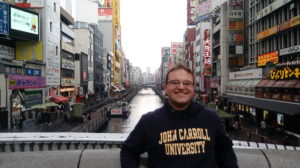
I spent the second semester of my Sophomore year at Kansai Gaidai University in Osaka Prefecture, Japan. That I went alone with no real connection and no peers, actually made the experience even more enriching because I was forced to branch out and not lean on the support structures, I had grown accustomed to during 20 years of life in Northeast Ohio. This lack of structure allowed me to connect with people and places that I never would have and to find a better understanding of my own fears and loves.
I arrived in Osaka via airplane in mid-January of 2019, the first few days were a whirlwind of excitement and orientation where I knew nothing and no one, however the first weekend gave way insecurity. I was lost and nervous till I started walking and watching life around me. Kids played in parks, laundry air-dried hanging from balconies, and people went to the Konbini(Convenience Store). Just as in Ohio, Japan was a place full of people simply trying to live their lives, just like me. That simple walk assuaged my fears and was the true start of a wonderful 5 months.
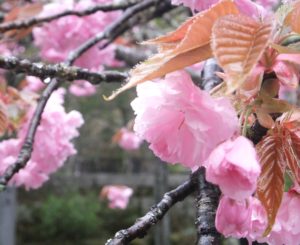
Walking introduced me to people from all over and by talking to them I quickly discovered group of friends from all over the world; Japan, Italy, Florida, Singapore, Australia, Canada, New Zealand, France, and even the remote exotic land of Ravenna, Ohio. Who knew I would find a friend from so close to home by traveling to the other side of the globe? My travels with my friends took us to shopping districts and vibrant urban centers, as well as densely forested mountains and gorgeous Buddhist Temples. These trips to the mountains and the monastic communities that were often centered on them helped me discover my deep fascination with Japanese religion. This worked in perfect tandem with the courses I was taking giving me both classroom and experiential learning all at the same time.
This fascination inspired me to take two solo trips centered on the Shingon Sect of Esoteric Buddhism, one of Japan’s oldest Buddhist sects. I undertook a section of the Shikoku Henro, Japan’s largest pilgrimage, a 1400-kilometer trek around to circumference of the island of Shikoku to 88 Shingon temples. I only had a few days so I visited the first 8 temples on foot and it was a wonderful trip where I was reminded once again of the wonders of people. I traveled for stretches with two different people. On the first day I walked for a while and was guided in the right direction by an elderly Japanese man, without his map I would have bee
n very lost. I spent my third day with an Irish travel writer who regaled me with tales of India and Central Asia. My other solo trip was to Mt. Koya the mountain, the center and location of the headquarters of Shingon Buddhism. The mountain is also home to one of the world’s oldest active cemeteries which has been active for over 1,100 years. The cemetery and temple complex is located in a forest of 100 foot tall cedars. It was the most fantastical feeling place I have been to in my life. I really can’t put it into words.
Coming back to America has been a mixed bag, I miss the places, people, and infrastructure of Japan, but I also love Ohio and home. I hope to go back, but I know because of that journey I gained a more nuanced appreciation for my home and for the struggle of newcomers to it. From a personal perspective I can now relate a little to feeling lost in a new place and part of the struggle people coming to America or more specifically Ohio face, but I also recognize I had an end date. I knew eventually that I would be going “home” for better or for worse. Many others don’t have that reassurance for reasons of both physical and economic security. However, I do know that my experiences, both struggles and joys, in Japan have made me a better more understanding person.
Note: Collin Derrig is Global Cleveland Research Associate , a 4th year student at John Carroll University from Cuyahoga Falls. This article discusses how study abroad in Japan shaped him and made him a better person.
A Brief History of Cleveland's Sister Cities
A Brief History of Cleveland's Sister Cities
- Written by Ezra Ellenbogen
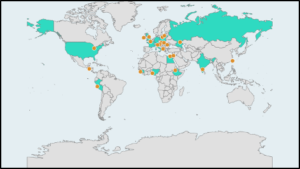
Image Credit to Jenika Gonzales via Global Cleveland
Cleveland has a very large number of sister cities - 23 to be exact.[1]This is quite a few, especially compared to larger cities in the US, such as Houston (18)[2] or San Diego (16)[3]. Cleveland’s sister city partnerships are not only quite numerous, but also, very historically, economically, and politically significant. First, let’s look at the overall rise in the concept of sister cities - and then Cleveland’s own history with them.
Although cities had been unofficially partnered before it became popular, the concept of sister cities gained traction only after World War II.[4] World War II left the world in a very fragile state, and most countries wanted to work towards new goals of international diplomacy, connectedness, and above all else, some form of peace. Average citizens wanted to create a sense of international community but did not have the resources to establish treaties or international organizations. “Sister Cities” or “Twin Towns” became popular, starting in Europe. Towns on opposing sides of past or current conflicts created partner city programs to spread culture and a sense of community, as well as to primarily try to undo any sense of mutual animosity. In the 1950s, The Council of European Municipalities made the “sister city” movement a priority for European localities. In 1956, US President Dwight D. Eisenhower created the Sister Cities International Organization, a nonprofit that promotes international sister city connections and aims to foster bonds between cities and regions.[5]
The most prevalent trends of the post-WWII rise of sister cities are in sister cities in areas that were formally in conflict, including, most prominently, partnerships between the UK and France and partnerships between the US and Japan. Another trend that can be observed is the natural tendency of cities to create relationships with cities that have the same (or a very similar) name as them, though this can be seen even before WWII. Most interestingly, US geographic trends show that West Coast cities are more likely to pair up with Japanese cities, whereas East Coast cities are more likely to pair up with European cities.
Even though sister city partnerships have become more economically-motivated in recent years, Cleveland and numerous other cities have done amazing jobs creating important cultural connections between cities as far as continents away, while also being able to maintain economic relations.
In 1964, under the Mayoral Administration of Ralph S. Locher, Cleveland founded its first sister city partnership with the city of Lima, Peru. This partnership was the result of an initiative by the Women’s City Club of Cleveland. The decision to create the partnership was made in collaboration with Lima City Councilman Fortunato O. Brown. In 1965, a delegation from Northern Ohio, led by Mary Hirschfield, the Plain Dealer’s Latin American correspondent, toured Lima, Peru, and met with the city’s (then) mayor, Luis Bedoya Reyes. The sister city partnership was very exciting for the city and even inspired local suburbs to start their own, though more Cleveland sister city partnerships would not be created until 1973.
In 1971, Mayor Ralph J. Perk took office. Mayor Perk was well known for his participation in the affairs of Cleveland’s Eastern European communities from which he hailed. In 1973, Perk’s administration created a second sister city relationship - with Brașov, Romania. Nicolae Ceaușescu himself chose Cleveland for a new sister city, as a part of a broader political strategy to undermine the USSR’s exertion of its political sphere. Cleveland was the 10th largest city in the US at the time, and the sister city partnership set an important precedent for Romanian foreign policy. However, Mayor Perk saw the partnership as a new avenue into cultural and economic opportunities, and his administration went on to establish ten sister city partnerships, as well as reportedly pursuing partnerships with seven more cities. Cleveland’s high number of sister cities is one of the most prominent legacies of the Perk Administration.
Subsequent mayoral administrations did not dedicate much energy to international relations, focusing instead on domestic issues. Cleveland was pulled back into the global stage with the Cold War. In 1985, left-leaning residents of Shaker Heights and Cleveland Heights sought a partnership with the Soviet city of Volzhsky, an effort which succeeded by 1988. Nearby Clevelanders began to seek a similar city sister association with Volgograd. This was initially vetoed in 1989 but later established in 1990. These sister city partnerships (alongside many others in American cities) were influential to the development of detente between the United States and the Soviet Union. Resulting cultural change helped spread Russian culture through the city. At the time, Russian and Soviet culture was quite demonized, so this was an important step towards both detente and the bettering of relations. Business relations and agreements with the Soviet Union were helpful to the late USSR’s economic goals envisioned under Khrushchev, and even benefitted Cleveland companies.
The impressive successes of Cleveland’s association with Volgograd prompted further enthusiasm for establishing global relations. Under the administration of Michael R. White, six more sister city associations were forged. This included the sister city association with Miskolc, Hungary, which was highly anticipated because of Cleveland’s very significant Hungarian population. In fact, Cleveland’s Hungarian population has historically been one of the largest globally.[6] Unfortunately, Fort Worth, Texas was first in line to create a partnership with Budapest, though Hungarian-Clevelanders were still very excited to have connections with Hungary.
By the start of the 21st century, the administration of Jane L. Campbell established two more sister city associations. Under the current administration of The Honorable Mayor Frank G. Jackson, 4 more sister city associations have been founded - including, most recently in 2019, one with Beit-She’an, Israel.
Finally, here is a quick rundown of the “four waves” of Cleveland’s sister cities.
1964 - Lima, Peru
1973-77 - Brașov, Romania; Ibandan, Nigeria; Ljubljana, Slovenia (then Yugoslavia); Taipei, Taiwan; Bangalore, India; Alexandria, Egypt; Holon, Israel; Cleveland, UK
1990-95 - Volgograd, Russia (then the USSR); Gdańsk, Poland; Bratislava, Slovakia (then Czechoslovakia); Conakry, Guinea; Segundo Montes, El Salvador; Klaipėda, Lithuania; Miskolc, Hungary
2003-19 - West Mayo, Ireland; Bahir-Dar, Ethiopia; Fier, Albania; Rouen, France; Vicenza, Italy; Beit-She’an, Israel
Cleveland has a very important history as a global city. From Lima to Beit-She’an, every single one of Cleveland’s sister cities has been incredibly important to the cultural and economic development of the city. Some prominent sister cities such as Rouen, France and Volgograd, Russia have had very significant histories that have shaped Cleveland and themselves. Cleveland has indicated it is open to new partnerships as well as maintaining its current ones. What’s for sure is that Cleveland will continue to strive for international diplomacy and multiculturalism through its diverse and historic sister city program.
- by Ezra Ellenbogen
Ezra's blog: One Page Stories
[1] https://case.edu/ech/articles/cleveland-sister-city-partnerships
[2] https://www.houstontx.gov/abouthouston/sistercities.html
[3] https://www.sandiego.gov/insidesd/san-diego-sister-cities
[4] https://priceonomics.com/why-do-we-have-sister-cities/
[5] https://sistercities.org/about-us/
[6] https://case.edu/ech/articles/h/hungarians
Cleveland and Rouen: A Pair of Sister Cities That Go Back 100 Years - By Ezra Ellenbogen
Cleveland and Rouen: A Pair of Sister Cities That Go Back 100 Years
-Written by Ezra Ellenbogen
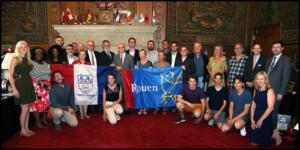
A Picture From the 10 Year Anniversary Celebration (clecityhall.com)
Although Rouen and Cleveland technically established their official sister city relationship in 2008,[1] the strong cultural and political relationship between the cities has existed for over a century. The sister city relationship between Rouen, the French city of around 112 thousand, and Cleveland, the American city of around 388 thousand, started unusually. That is, it started with a medical unit in World War I France.[2][3]
When World War I broke out, the American Ambassador to France, Myron Herrick (a Clevelander himself), asked renowned surgeon and physician, George Washington Crile, to organize a surgical team to assist French forces.[4] Dr. Crile recruited a team of volunteer nurses and surgeons from Lakeside Hospitals in Cleveland (now University Hospitals). The “Lakeside Unit,” as it was called, worked across Northern France, especially near Rouen and Paris. Through the two years of being stationed in France (1915-1917), the Lakeside Unit grew significantly in size and treated over 83,000 patients from both sides of the war. Dr. Crile and his group heavily changed the quality of overseas medical services for the better and were able to apply results from their work to further innovations in the medical field. Dr. Crile’s revelations and new medical ideas inspired him to co-found today’s Cleveland Clinic along with three other doctors from the Unit: Frank E. Bunts, William E. Lower, and John Philips.[5]
Cultural and economic links between the cities exist as well. First, French immigration to Cleveland never grew especially rapidly, and instead, developed gradually. That is, although the number of French immigrants was often rather low in pre-Industrial Cleveland, they certainly influenced the culture and diversity of the city and its surrounding region over time.[6]
As for economic ties: a handful of Cleveland companies, including most prominently, Lubrizol, Lincoln Electric, and MTD Products, are major employers in Rouen.[7][8] In fact, business ties helped drive the decision to partner the cities. Yannick Le Couedic revived the local chapter of the French-American Chamber of Commerce and encouraged the city of Cleveland to build on its foundation of relations with Rouen. Le Couedic is a retired Lubrizol executive who grew up in France and lived in Northeast Ohio. In 2008, Mayor Frank G. Jackson established a sister city partnership with Rouen with hopes of economic and cultural exchange. This sister city relationship went on to become one of the most productive, as well as one of the most culturally and economically significant that Cleveland has ever had.
Since it was established, the Cleveland-Rouen sister city relationship accomplished numerous goals. In January 2008, a delegation from Rouen visited and toured Cleveland Clinic. Since then, medical facilities in both cities have kept in touch. Later, the head of MTD Products in France, Philippe Obadia, checked out a new commercial mower in Cleveland and toured MTD factories across the state. Airlines, businesses, mayors, artists, and more have all been involved in the action.
In 2018, Cleveland and Rouen’s sister city relationship reached its 10th anniversary, strong as ever. In celebration, Cleveland and Rouen had a ‘mural exchange’ project and coordinated a Bastille Day celebration on July 14th in Cleveland. Bastille Day is a French national holiday commemorating the storming of Bastille - a fortress and prison - on July 14th, 1789, an event which helped usher in the French Revolution.[9] The 6-hour Bastille Day reflected French culture with a celebration that included food, live entertainment, and more.
The mural project started with Paatrice Marchand, a Rouen artist, creating the well-known “fried eggs” mural on the side of Market Garden Brewery.[10] The mural depicts fried eggs floating about the sky like clouds, and says, “If you see a cloud behind the sun, it must be an egg.” Later that year, local Cleveland artist Lisa Quine was chosen to paint a mural in Rouen in collaboration with French graffiti enthusiast group “Idem & Mozaik.” The roughly 2,500 square feet large mural ended up as a splash of color and geometry, with a broad banner that reads “All colors are beautiful.[11]”
Rouen and Cleveland have a strong sister city partnership that has promoted economic and cultural development and exchange. In fact, the two cities, in collaboration with the French-American Chamber of Commerce, are designing and launching a French cultural garden in Cleveland by Spring 2020.[12] You can find out more about this exciting project at faccohio.org/foundation. From the arts to business, Rouen and Cleveland have helped develop each other culturally and economically. Here’s to another 100 years of good relations!
- by Ezra Ellenbogen
Ezra's Blog: One Page Stories
[1] https://case.edu/ech/articles/cleveland-sister-city-partnerships
[2] https://www.worldometers.info/world-population/france-population/
[3] https://www.worldometers.info/world-population/us-population/?TB_iframe=true&width=370.8&height=658.8
[4] https://www.cleveland.com/metro/2017/04/cleveland_clinic_co_founder_george_crile.html
[5] https://ohiohistorycentral.org/w/Cleveland_Clinic
[6] https://case.edu/ech/articles/f/french
[7] https://www.cleveland.com/business/2008/04/it_was_the_war_to.html
[8] https://clecityhall.files.wordpress.com/2018/07/2018-rouen-cleveland-sister-city-10th-anniversary-proc.pdf
[9] https://www.history.com/topics/france/bastille-day
[10] https://clevelandtraveler.com/cleveland-mural-guide/
[11] https://rouen.fr/idem-mozaik
[12] https://www.faccohio.org/foundation.html
Taipei and Cleveland - By Ezra Ellenbogen
Taipei and Cleveland
- Written By Ezra Ellenbogen
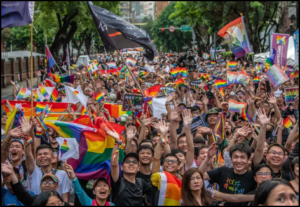
An image of a Pride event in Taipei
Image Credit to Carl Court / Getty Images
June is Pride Month in the United States! In the United States, LGBTQ+ rights have come a long way since the original Stonewall riots (though there is still some progress to be made), but globally, LGBTQ+ citizens are most often not given the same rights as straight citizens, and even sometimes considered illegal. Unfortunately, Asia is home to little progress in this field, but Taiwan has pioneered LGBTQ+ rights in a region where such rights are almost unheard of.[1]Taiwan’s capital is Taipei - and the city of Taipei is a sister city of Cleveland. First - a bit of background.
On September 25th, 1975, former Cleveland Mayor Ralph J. Perk and former Taipei Mayor Lin Yang-Kang partnered their cities as sister cities.[2] Taipei City is a very friendly city, as shown with their total of 52 sister city partnerships (Cleveland has 23 including Beit-She’an).[3] In 1985, Taipei City generously gifted the Chinese Cultural Garden to Cleveland.[4] The beautiful garden was modeled after the Chinese Imperial Palace and includes two Chinese dragon statues as well as one of Confucius. In 1990, the state of Ohio and Taiwan became “sister states.[5]” Ties between the two regions have been positive throughout the sister city relationship.
In 2016, Taiwan was the 6th largest export market in Asia for Ohio. Business interactions between Taiwanese businesses and the city of Cleveland have helped diversify the reach of numerous Taiwanese products. Moreover, Taiwanese students have had numerous scholarly opportunities in Cleveland, especially with Case Western Reserve University. Reciprocally, Cleveland students have had similar academic opportunities in Taiwan, and both sides of the exchange have helped spread Taiwanese and Cleveland culture.[6] For instance, in May 2019, 16 Taiwanese high-school-age music students visited the city of Cleveland, welcomed by a local delegation that later traveled to meet the same group in Taiwan. While visiting Cleveland, the students toured three world-renowned music conservatories across Northeast Ohio, learned about music therapy, and more. In Taipei in October, Cleveland’s delegation of 3 high-school students participated in local music-themed activities and music service learning projects, visited local temples, learned about playing the Chinese Zither (Guzheng), and more.
Taiwan is known for its progressiveness with LGBTQ+ rights, as well as its festive Pride celebrations. The country’s rights for members of the LGBTQ+ community are still developing, but they are certainly the most forward in the region. Taiwan has a large and flourishing LGBTQ+ community, and a record 200,000 people participated in Taipei’s 2019 Pride parade.[7] For comparison, 80,000 people attended the 2015 Taipei Pride event.[8] The main reason for the sudden influx of pride and celebration was that Taiwan legalized same-sex marraige that year. The struggle for LGBTQ+ rights in Taiwan has been a long and politically divisive one.[9] Taipei’s Pride march started in 2003, and since then, there has been a major political movement behind legalizing same-sex marraige in the country.
In 2016, the first female president of Taiwan, Tsai Ing-wen, was elected, and expressed clear support for the LGBTQ+ community as well as its members’ legal rights. In 2017, the Taiwanese constitutional court struck down the Civil Code’s definition of marriage being only between a man and a woman, and this led to a political struggle throughout Taiwan’s government that resulted in the 2019 legalization of same-sex marraige by President Tsai.
Taiwan is well-known globally for its modern Pride celebrations. In fact, Taiwan’s Pride parades most often include international groups. Taiwan is a beacon for LGBTQ+ rights in Asia, and the country’s Pride celebrations include Pride movements from other countries that are not supported by their own state, including prominent Hong Kong LGBTQ+ movements.[10]
Pride celebrations in Taiwan typically occur in the month of October, which is known as LGBTQ+ History Month, or sometimes Queer History Month. In the United States, Pride celebrations are typically in June, to commemorate the Stonewall riots. October was chosen for other countries’ Pride months to coincide with Coming Out Day - which is October 11th.[11]
Taipei City and Cleveland have a history of cooperation and beneficial cultural exchange. Moreover, now is a good time to recognize and appreciate the progress made by Taiwan, not only for its cultural diplomacy with the United States and especially Cleveland, but also for its wondrous progress with LGBTQ+ rights. It is important to recognize the progress that has been made globally, as well as what still needs to be accomplished.
Happy Pride Month!
[1] https://www.ozy.com/news-and-politics/special-briefing-is-asia-becoming-gay-friendly/94470/
[2] https://english.sec.gov.taipei/cp.aspx?n=2789B64DFDD8B838
[3] http://www.tcc.gov.tw/en/cp.aspx?n=81569D74DD82C7DB
[4] https://case.edu/ech/articles/c/cleveland-cultural-gardens
[5] https://english.moe.gov.tw/fp-117-22292-DAE02-1.html
[6] https://www.ccwa.org/building-bridges-from-cleveland-to-taiwan/
[7] https://focustaiwan.tw/society/201910260006
[8] https://oftaiwan.org/social-movements/lgbtq-movement-in-taiwan/
[9] https://www.nytimes.com/2017/05/24/world/asia/taiwan-same-sex-marriage-court.html?mwrsm=Facebook&_r=0
[10] https://www.nbcnews.com/feature/nbc-out/taiwan-pride-bigger-ever-beacon-lgbtq-rights-asia-n815641
[11] https://www.wright.edu/diversity-and-inclusion/culture-and-identity-centers/lgbtqa-affairs/international-lgbtqa-dates-to-know
Braşov and Cleveland - By Ezra Ellenbogen
Braşov and Cleveland
- Written by Ezra Ellenbogen
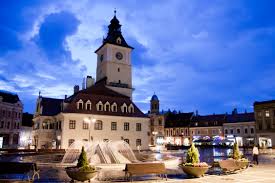 Braşov [Hungarian: Brassó], Romania is a beautiful city tucked into a Southern region of the Carpathian mountains known as the Transylvanian Alps. The city has a rich history and culture located on the edge of southeastern Transylvania, along one of the most historically important trade routes in Romania’s history.[1] It is the capital of the Braşov judet in Romania, and has a population of over 275,000.[2] Braşov was twinned with Cleveland in 1973 as Cleveland’s second ever sister city.[3] The charming multicultural city was founded in the 13th century at the center of trade between the Ottomans and Europe.[4]
Braşov [Hungarian: Brassó], Romania is a beautiful city tucked into a Southern region of the Carpathian mountains known as the Transylvanian Alps. The city has a rich history and culture located on the edge of southeastern Transylvania, along one of the most historically important trade routes in Romania’s history.[1] It is the capital of the Braşov judet in Romania, and has a population of over 275,000.[2] Braşov was twinned with Cleveland in 1973 as Cleveland’s second ever sister city.[3] The charming multicultural city was founded in the 13th century at the center of trade between the Ottomans and Europe.[4]
The city thrived as a result of extensive trade with European merchants and other Romanian cities. However, a few hundred years after being founded, Braşov was captured and temporarily occupied by Turkish forces (1421). The city soon surrounded itself with strong walls to deter invaders - which worked. In 1432, when forces attempted a second invasion of the city, Braşov was able to hold them off. Although these walls were built for the purpose of geopolitical safety, they soon became part of the reason the city flourished.
The sheltered Transylvanian city soon became an influential and multicultural center of Romania, economically and culturally. German mercantile groups became prominent in the city, and European merchants and workers (as well as the original Dacian settlers) soon built up the city. Braşov became a center of trade between the three distinctly separated regions of Romania, and drove the country forward.
A few hundred years later in the late 1800s, Romanians began to settle in Cleveland, many driven away from their home country. Cleveland’s new Romanian population was primarily from Transylvania - which was then under the rule of Austria-Hungary. By the outbreak of the First World War, Romanians numbered 12,000 in Cleveland.[5] The main concentration of Romanian immigrants was around Detroit Avenue on the West Side, between W. 45th and W. 65th Streets. These areas of Cleveland were already known for Irish and German immigrant populations, and the introduction of Romanians further diversified the iconic area. Collinwood, Bedford, and Lakewood had their own Romanian populations as well. Lorain accumulated a Romanian population too, and contact between Romanian populations in all of these areas was always kept strong. Many Romanian communities across the area were not self-sufficient enough to thrive, and most Romanians ended up consolidating into a population on the West Side. By World War Two, most of the Romanian population had followed the general migration towards the West Side. Moreover, many Romanian immigrants did not end up initially settling in rural areas because it was hard to quickly find capital to start a farm - though Romanian immigrants who enjoyed the rural life were soon able to find themselves in farms again not too long after immigrating.
The original intent of much of Romanian immigration was not permanent residence in the city, though by the end of the First World War, many Romanians found that Cleveland suited them. During the years of the Post-War Period, around half of Cleveland’s Romanian population returned home, leaving Cleveland’s Romanian population at 6,000. Many of these Romanians were incentivized to return home by the news that Transylvania and Bucovina had become part of Greater Romania. There was also a movement of Romanians who settled in Cleveland, as well as some who went back to Romania to find a family, then went back to America with them. The American immigration restrictions introduced in the early 1920s slowed down most immigration patterns. By 1940, the population of Romanians in Cleveland numbered only 4,000.
The political outcome of World War Two in Romania was displeasing to numerous groups of Romanians, many of whom ended up immigrating to America as a result. After World War Two, a Communist regime had been put into place at the head of Romanian society, which drove 2,000 Romanians into Cleveland alone (not only from Transylvania, but from all over the country). The West Side area that was formerly a Romanian hotspot began to break apart with new waves of immigration from numerous areas, and many newer generations in the area moved out west to suburban regions. New Romanian waves of immigration continued the legacy of the area, but it is now much more diverse, with a wide range of immigrant populations.
As a result of all these periods of Romanian immigration, Greater Cleveland is now not only home to about 20,000 Romanians,[6] but also numerous Romanian-American national societies and organizations, like the Carpatina Society.[7]Moreover, Cleveland’s historic relationship with Romania led former Romanian President Nicolae Ceaușescu to visit the city in 1973 and encourage extensive trade between Romania and Cleveland companies.[8] Efforts between Romania and Cleveland to incentivize trade and cultural relations have been strong throughout history. A host of Romanian politicians have visited Cleveland, from former Braşov mayor, Dumitrache, to Minister Draganescu.[9] Further, Romanians loved “The Singing Angels” on the band’s visit to the country in 1974, and Clevelanders got to welcome Nadia Comaneci, the first gymnast to get a perfect score of 10.0 at the Olympic Games.[10]
Cleveland and Romania, even through numerous political troubles and disputes, have been global partners culturally and economically. The influence of Romanian immigration to Greater Cleveland can still proudly be seen today. The Cleveland-Braşov sister city relationship has emphasized the current and historical success of Romanian-American endeavors and cooperation.
[1] https://www.balkantrails.com/brasov-rich-history-in-the-heart-of-romania/
[2] https://worldpopulationreview.com/countries/romania-population/cities/
[3] https://case.edu/ech/articles/cleveland-sister-city-partnerships
[4] https://www.gpsmycity.com/blog/brasov-the-heart-of-romania-2404.html
[5] https://case.edu/ech/articles/r/romanians
[6] https://www.cleveland.com/metro/2016/08/three-day_romanian_festival_on.html
[7] https://ohiohistorycentral.org/w/Carpatina_Society
[8] https://www.nytimes.com/1973/12/08/archives/ceausescu-urges-us-business-to-invest-in-rumania-president-cites.html
[9] https://books.google.com/books?id=fjgtAAAAMAAJ&pg=PA290&lpg=PA290&dq=Brasov+and+Cleveland&source=bl&ots=xDsY7JFybu&sig=ACfU3U0A9hrUAthChP9tNiVg0zZ49lBwQQ&hl=en&sa=X&ved=2ahUKEwjTxa_E3qnpAhWGZM0KHeW5C-QQ6AEwCXoECAoQAQ#v=onepage&q=Brasov%20and%20Cleveland&f=false
[10] https://books.google.com/books?id=B8DUAAAAMAAJ&pg=PA446&lpg=PA446&dq=Bra%C5%9Fov+Cleveland&source=bl&ots=yhOhcjqXQM&sig=ACfU3U3ev91muW23z4I-og1oBZZyDQFPEA&hl=en&sa=X&ved=2ahUKEwiqksjDwbvpAhWFHc0KHVngApUQ6AEwCHoECAoQAQ#v=onepage&q=Bra%C5%9Fov%20Cleveland&f=false
Cleveland and County Mayo: A New “Angle” on Cleveland - Ezra Ellenbogen
Cleveland and County Mayo: A New “Angle” on Cleveland
- Written by Ezra Ellenbogen
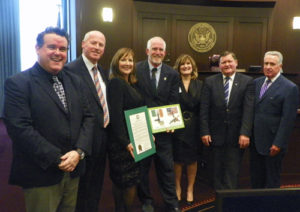
County Mayo, located along parts of the northwestern coast of Ireland with a population of around 130,000, has been twinned with the city of Cleveland since 2003.[1] This sister city relationship was a result of uniquely Irish immigration patterns as well as community bonds that led to Cleveland’s rise as an Irish home. From traditional culture and westward immigration to the “Angle” community, the story of Irish relations with Cleveland is a detailed and interesting one.
Between 1820 and 1825, the first Irish immigrants arrived in Cleveland. Even from the start, most of the Irish immigrants in Cleveland hailed from County Mayo.[2] In 1825, the construction of the Ohio and Erie Canal began, and workers were needed. This coincided with the increased immigration of Europeans from poorer areas, including the Irish, who numbered around 500 by 1826.[3] Many of the Irish workers who flocked to Cleveland for the jobs the canal project provided originally meant to stay temporarily, but the 1827 extension of the project resulted in the dense settlement of the Irish around the so-called “Irishtown Bend.” With the start of the Industrial Age and the numerous jobs it brought along with it in Cleveland, immigration flourished, especially Irish immigration. Even though Irish immigration to Cleveland was mostly from the County Mayo region, an agrarian area, Irish immigrants in Cleveland were hard workers during the Industrial Age and contributed greatly to Cleveland's Industrial economic boom.
Irish Clevelanders reached more significant numbers by the late 1840s. As a result of Potato Famine Immigration (the patterns of mass emigration from Ireland to the United States because of Irish potato famines), Irish Clevelanders numbered over 1,000 by 1848. The Civil War’s need for transportation of people and cargo brought even more jobs to Cleveland and worked with the Industrial Age to invigorate further Irish immigration. Irish immigration to the city only grew more rapidly from there. By 1870, the Irish population grew to be over 10,000, or 10% of the city’s population at the time. In 22 years (1848-1870), the Irish population in the city went up almost tenfold. During the 1860s and 1880s, horrible weather in County Mayo (particularly Achill Island) drove even more Irish people to emigrate. Although Irish immigration kept a relatively rapid pace, it did not keep up with Cleveland’s overall boom as a city. By 1900, the 13,000-some Irish represented only 3.5% of the city’s population.
Irish immigrants in Cleveland tended to cluster in densely populated areas, often earning those parts of the city unique names. Not only was there the ‘Irishtown Bend,” where canal workers settled, but there were many other areas, each with their own nickname. The area west of the river by the lake in Cleveland earned itself the name the “Achill Patch,” in honor of Achill Island in County Mayo, the original home of many of the Irish settlers. Most famously, there was “The Angle,” or “The Triangle.” This area, defined by its large Irish population and St. Malachi Parish, has been broken up by geographic changes but remains a strong community. It was, at its peak, the most famous Irish area of Cleveland.[4] It is interesting to note that most of these areas were close to each other, and by some definitions, overlapped.
The Angle was defined as the roughly triangular area between West 28th Street, Division Avenue, and River Road[5], across from Whisky Island (hence the name, “The Triangle”). It mainly consisted of Irish houses and shops. The cultural center of the neighborhood was St. Malachi Parish, which was founded in 1867. However, the whole West 25th Street area, from 1860 and onwards, was known as a very Irish area. At one point, St. Malachi Parish listed 2,000 Irish families in the region. The Angle only grew, and soon came to include most of the area north of Detroit Avenue that sloped down to the well-known angled riverbed. In 1917, the Detroit-Superior Bridge project started to geographically break up the Irish community in the region. Later, the Lakeview Terrace Housing Project and other bridges (including part of the Cleveland Memorial Shoreway) struck a geographic barrier between parts of the Irish region. Though the area remains an Irish neighborhood, many of the inhabitants of the old Angle left for other areas. However, St. Malachi Parish’s Sunday services still attract many from the old community.
An 1881 Map of Cleveland With “The Angle” Marked, Image Credit to the Irish American Archives Society
When they arrived in Cleveland, many Irish immigrants flocked to the police force and politics. The prejudice expressed at the time by many Americans was the idea that Irish immigrants were all supposedly criminals. Ironically, Irish immigrants were more often police officers than most else. In 1874, Cleveland’s Irish population made up 10% of the city’s total population and 20% of the city’s police population. In 1902, it was 3.5% and 12.5% respectively. Later, as Irish immigrants assimilated more into Cleveland, the proportionately large percentage of them on the force shrank. The Irish population of Cleveland grew to influence many aspects of the city and its culture.
In 2003, under Mayor Jane Campbell, Cleveland partnered as a sister city with County Mayo. This was a celebration of the ancestral lineage of most Irish Clevelanders from that region as well as the creation of numerous new business and social opportunities between Irish and Cleveland communities. Stephen Mulloy spearheaded the effort with years of planning.[6] In July 2003, a Cleveland delegation of Mayor Campbell, Stephen Mulloy, and prominent Irish Clevelanders visited County Mayo. Later in the same year, the Chairman of the Mayo County Council and other delegates visited Cleveland. During that October event, delegates from both areas celebrated Irish heritage in the city with numerous newspapers, notes, documents, and other artifacts from Irish immigrants in the region.
This relationship went on to inspire many others. For instance, the Mayo Society of Greater Cleveland and Údarás na Gaeltachta (Gaeltacht Authority) have become business partners as a result of the connection between the two areas.[7]In fact, in 2018, the Mayo Ball saw the arrival of people and businesses from County Mayo and nearby Irish counties, and three Irish companies presented their products and companies to Clevelanders and businesses alike. Delegates and political representatives from County Mayo attended the event, alongside representatives from Cleveland Irish American groups.
At the same event, many who attended worked together to form plans for International Mayo Day, an annual international celebration of all things County Mayo. The event started in 2015 and has been held yearly since in Western Ireland. There, international spectators and locals alike celebrate everything about County Mayo culture, from literature to business. Moreover, the holiday has extended into the US, the UK, and beyond as local County Mayo populations celebrate their heritage.[8] This is all thanks to Martina Hughes of Mayo county council, who had thought of the idea originally. If you’d ever like to help celebrate Cleveland’s County Mayo heritage, May 4th is International Mayo Day.
County Mayo is truly a wondrous land, with astounding coasts and stunning culture. They’re known for their diaspora and immigrant populations in other areas. In fact, while County Mayo numbers around 130,000 people, the diaspora of the county is over 3.5 million strong. Cleveland is more than proud to work with County Mayo and celebrate the contributions of Irish immigrants to the city. Without Irish immigration, from the Achill Patch to the Angle, Cleveland would not be where it is today.
- By Ezra Ellenbogen
Ezra's blog: One Page Stories
[1] https://case.edu/ech/articles/cleveland-sister-city-partnerships
[2] https://case.edu/ech/articles/i/irish
[3] http://www.irisharchives.org/pdf/IrishAndAngle.pdf
[4] http://www.clevelandmemory.org/iac/articles/Irangle.html
[5] Some sources defined it by the riverbed instead of a third road
[6] http://ead.ohiolink.edu/xtf-ead/view?docId=ead/OCLWHi0286.xml;query=;brand=default
[7] https://ohioirishamericannews.com/2018/11/04/the-green-and-red-ball-mayo-celebrates-again/
[8] https://www.irishtimes.com/special-reports/mayo-day/mayo-day-is-a-celebration-of-mayo-ness-worldwide-and-has-grown-over-last-5-years-1.3864953
A History of Slovenians in Cleveland
A History of Slovenians in Cleveland
- By Ezra Ellenbogen
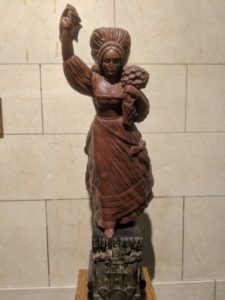
Ljubljana [lyoo-BLYAH-nuh], Slovenia is a city of over 270,000 twinned with Cleveland in 1975.[1][2] It is the centrally-located capital and largest city of Slovenia and has a very cosmopolitan culture, hosting over ten thousand cultural events annually.[3] Cleveland’s sister city partnership with Ljubljana was developed to recognize Cleveland’s historic Slovenian population. Cleveland has always been a city with a significantly high Slovene population - the city had the largest Slovene settlement group in the US for approximately ninety years[4], and is now the city with the largest Slovene population outside of Slovenia.[5] Slovenian development in Cleveland followed interesting patterns unique to their ethnic group.
Between the 1880s and the start of World War I, Slovenia experienced a significantly large pattern of immigration, particularly into the United States. Coveting newly created mining jobs in the United States, many Slovenians immigrated, especially to the areas of Georgia (in the 1730s), Michigan (Calumet), Wisconsin, Minnesota (Brockway), Illinois (Joliet), Iowa, Nebraska (Omaha), and Ohio (Cleveland).[6] However, Slovenians feared the American prejudice against Slavic (and especially Slovenian) people at that time. Thus, upon immigration, many said they were Austrian or Slavonic. Slovenian immigrants tended to quickly assimilate into new workplaces while maintaining strong cultural ties through their establishment of Slovenian settlements.
The most pronounced periods of Slovenian immigration into Cleveland were between 1890-1914, 1919-24, and 1949-60. Mass immigration from Slovenia was at first prominent before the start of World War I and eventually resurfaced following World War II and political troubles in Slovenia. However, the two distinct immigration groups (pre-WWI and post-WWII) were demographically dissimilar. Most immigrants who came before the start of World War I were of an economically underdeveloped and rural demographic. Immigrants to the US following World War II were mainly political refugees, hence a larger proportion were professionals and well-educated. The Slovenian community of Cleveland was drastically changed post World War II, with the introduction of not only higher educated Slovenians, but also of emigres from other Slovenian settlements in the US. Cleveland became principally attractive to the 2nd-generation-Slovenian-emigres because of the rapid expansion of its industrial sector, which called for large amounts of unskilled and semiskilled labor that Cleveland did not have. Moreover, at that time, the demographics of the American job market gave Slovenians an advantage, because the labor base was predominantly German, and many Slovenians knew German, especially those who emigrated pre-WWI. From the early 1900s until the late 1990s, Cleveland had the largest Slovene settlement group in the United States.
The Newburgh area (near the south side of Cleveland) was the epicentre of the initial Slovenian migration, followed by the area around St. Clair Avenue. Collinwood soon became established as a Slovenian settlement, expanding into Euclid. After the 1980s, cities in Lake County became points of interest for Slovenian immigration, and eventually so did Garfield Heights and Maple Heights. Interestingly enough, no successfully independent Slovenian settlements emerged in the West Side of Cleveland. Indicators at the time showed that Cleveland Slovenians, even as they acquired US Citizenship, were not giving up their heritage and certainly not culturally assimilating. This was unlike other groups that either entirely assimilated or remained entirely separated.
A rift of ideology grew among Slovene Clevelanders. This was strongly reflected in the liberal Slovene-language newspaper Enakopravnost’s conflict with Slovenian conservative religious groups in the city. By 1914, Slovenian Clevelanders were mostly split between conservative Catholics and “freethinking” liberals (many of whom identified as socialists). There were no major conflicts as a result of the ideological divide. However, a roadblock in the process of Slovenian immigration to Cleveland came with the start of World War I.
During that time, Slovenians in Cleveland flourished culturally and somewhat economically, despite a lack of new immigrants. Once the First World War ended, Slovenian immigration to the city gradually increased, and many professionals and higher-educated groups became prominent parts of Slovenian-American society. This led to the growth of successful careers for many Slovenian-Americans, including Frank John Lausche, a prominent Eastern European politician who later served as the first Eastern European mayor of Cleveland.[7]
The rise of World War II in Europe complicated the ideological divide in Cleveland. Slovenia, a part of Yugoslavia at the time, was split between rival resistance groups, and thus, Slovenian Clevelanders grew increasingly split based on their political opinions (pro-Communist/pro-Titoist against anti-Communist/pro-Religious-Conservativism). But World War II also saw a new period of Slovenian immigration to America, with thousands of new Slovenians coming to the US, especially Cleveland. The post-WWII emigres were typically better educated and viewed with politically-based suspicion from the more progressive wing of Slovenian Americans. Despite the growth of the ideological divide, post-WWII immigration reinvigorated Cleveland’s Slovenian cultural scene. Moreover, the ideological divide never led to any major conflict between Slovenian Clevelanders.
In 1975, former Cleveland Mayor Ralph Perk forged a sister city relationship with the capital of Slovenia as an acknowledgement of the long history of Slovenians in Cleveland. In fact, Perk reported that, among the many sister cities he partnered with, he was most proud of his efforts to associate Cleveland with Ljubljana. By the 1990s, the Slovenian population in Cleveland numbered well over 50,000, many of whom were still connected to their homeland culturally and linguistically. Although the city no longer has the largest individual Slovene-American settlement group, the number of Slovenians in the city has now surpassed 80,000, making Cleveland home to the largest Slovene population outside of Slovenia.[8]
Cleveland’s connection to Ljubljana is stronger now than ever, especially after a friendly 2011 meeting between Jurcek Zmauc, the consulate general of the Republic of Slovenia in Cleveland, and Mayor Frank Jackson.[9] Zmauc is well-aware of the connection between Slovenians and Cleveland, having said that “There is no village in Slovenia that does not have relatives in Cleveland.” The former mayor of Cleveland’s sister city, Vicenza, Achille Variati, also attended. Cleveland has worked diligently to form initiatives in the Eastern European region to lure new talent to the area, and to cooperate effectively with our many sister cities.
Cleveland’s history with Slovenia is a long and interesting one, reflecting the unique nature of Slovenian immigrants in the region. Many call Cleveland a Slovenian city, for the city reflects not only the cultural and historic values of Slovenian-Americans, but also mirrors the culturally cosmopolitan nature of Ljubljana itself. Although Slovenians in Cleveland have had historical ideological divisions and disputes, the community is still incredibly strong and interconnected. Our relationship with Ljubljana is one of the most important and historic sister city relationships Cleveland has ever forged, and the city looks forward to an enduring continuation of this historic bond.
- By Ezra Ellenbogen
Ezra's blog: One Page Stories
[1] https://www.worldometers.info/world-population/slovenia-population/
[2] https://case.edu/ech/articles/cleveland-sister-city-partnerships
[3] https://www.timeshighereducation.com/student/where-to-study/study-in-slovenia
[4] https://case.edu/ech/articles/s/slovenes
[5] https://clevelandhistorical.org/items/show/289
[6] https://www.everyculture.com/multi/Pa-Sp/Slovenian-Americans.html
[7] https://case.edu/ech/articles/l/lausche-frank-john
[8] https://toursofcleveland.com/cleveland-city-hall-sister-city-ljubljana/
[9] https://www.cleveland.com/metro/2011/04/cleveland_to_seek_new_ties_wit.html
The Two Clevelands
The Cleveland Hills in England, Image Credit: Northyorkmoors.org.uk
The Two Clevelands
-By Ezra Ellenbogen
Cleveland is a city in Ohio in the United States, but Cleveland is a region in Britain that was formerly a county. It’s easy to get the two confused. You’ve probably encountered this phenomenon before - two towns with the exact same name! Whether it be Toledo, Ohio and Toledo, Spain or Newcastle, Australia and Newcastle, Britain, there are many towns and cities whose names are the exact same. Two of these name-twins are Cleveland in the US and Cleveland in the UK. It is no wonder that they’ve been paired as sister cities since 1977![1]
As you know, the sun did eventually set on the British Empire, but many names of theirs have stuck around - a lot of them. In fact, BBC America estimated that 650 cities in the US have an English town as their namesake.[2] Another interesting fact about this phenomenon: Richmond is the British place name most copied internationally.[3] And if you haven’t heard of these twin-named-cities, take out a map and take a gander at such cities as London, Ohio, Birmingham, Alabama, and even Boston, Massachusetts. But the story of the two Clevelands is not just another tale of an American city named after an English city.
To mention, there is a common falsehood that Cleveland in England and in Ohio have two separate etymological origins. As you’ll see, they do not entirely.
Cleveland in England got its name from the old English clif meaning slope and land meaning land. The area’s name means “cliff-land,” in reference to the Cleveland Hills that bore the same etymology. Although, when the county was established, it did not include the traditionally defined Cleveland Hills area.
However, Cleveland in Ohio got its name from Moses Cleaveland, the person who began the settlement of the city. The city remained Cleaveland until 1831 when The Cleveland Advertiser dropped the ‘a’ in the city’s name because it was, according to them at least, superfluous.[4] This change created a new norm and the city has been known as Cleveland ever since. It is funny to note that the Herald newspaper continued its usage of the ‘a’ at least a year after the spelling changed.
To look further, the surname Cleaveland actually has two possible meanings. Firstly, it could come from an Americanized spelling of the Norwegian surname Kleveland/Kleiveland, which came from the Old Norse klief, meaning cliff, and land meaning land. Secondly, there is the surname Cleveland/Cleaveland, which fits the explorer’s last name perfectly. This name actually is a direct reference to the Cleveland area of England and means ‘of Cleveland.’ Essentially, the two surnames bear the same meaning.[5]
Looking into Moses Cleaveland’s genealogy, we make the following observations. First, his family had no need to Americanize their name considering that their name was Cleaveland before Americanizing names was even common. Second, since the family has direct ancestry from England, it is more than most likely that their surname originated from the common surname Cleveland in reference to the English region. So unless you think that someone from Norway Americanized (or rather, English-ified considering the concept of Americanization didn’t even exist then) their surname and went to England to influence Moses Cleaveland’s ancestors to adopt the name, then it is safe to assume that his last name comes from the English region of Cleveland.
So, Cleveland, Ohio was named for Moses Cleaveland, whose last name meant ‘of Cleveland,’ in reference to the area of England. Thus, Cleveland was named for Cleveland, despite the common falsehood.
It was no wonder when Mayor Ralph Perk sought out Cleveland, Britain as a sister city in 1977.[6] Besides just their names, the two Clevelands have much in common. The two cities industrialized at similar times, with Cleveland, Ohio becoming an important industrial city in the mid to late 1800s[7] and Cleveland, England playing a large role in the 19th century iron boom.[8] For a while, Cleveland had a similar population to its English counterpart, but our headcounts have since diverged. A fairer comparison would be between Cuyahoga County and the Cleveland region. That comparison would show that Cuyahoga County’s population is almost twice that of Cleveland, England.[9] However, Cleveland, England’s population has been growing as the area continues its development. Unfortunately, Cleveland has not been an official county since 1995, but its name lives on as a regional name, such as with its usage as a postcode district (and also in the borough of Redcar and Cleveland).
So, Cleveland and Cleveland are two twin cities, with their names having an intertwined history. The two coastal areas will always have a connection, and Cleveland is proud of our relationship with our English counterpart.
Ezra's blog: One Page Stories
[1] https://case.edu/ech/articles/cleveland-sister-city-partnerships
[2] http://www.bbcamerica.com/anglophenia/2015/02/7-american-cities-british-namesakes/
[3] https://www.dailymail.co.uk/news/article-1102645/All-roads-lead-Richmond-British-place-copied-world.html
[4] https://books.google.com/books?id=-Og7AQAAMAAJ&dq=%22Cleveland%20Advertiser%22%201831%20spelling&pg=PA744#v=onepage&q&f=false
[5] https://www.thoughtco.com/cleveland-surname-meaning-and-origin-4068487
[6] https://case.edu/ech/articles/cleveland-sister-city-partnerships
[7] http://ohiohistorycentral.org/w/Cleveland,_Ohio
[8]http://www.city.cleveland.oh.us/CityofCleveland/Home/Government/MayorsOffice/Office_of_Government_Affairs/SisterCities#cleveland
[9] https://www.plumplot.co.uk/Cleveland-population.html






